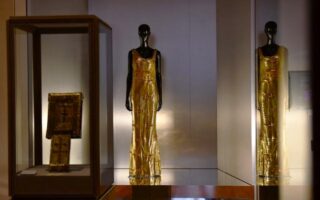Street Art Fringe Culture
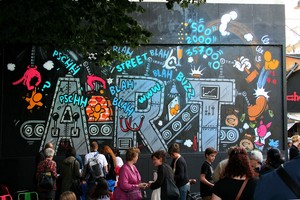
- SUBSCRIBE
- ALREADY SUBSCRIBED?
BECOME A BONJOUR PARIS MEMBER
Gain full access to our collection of over 5,000 articles and bring the City of Light into your life. Just 80 USD per year.
Find out why you should become a member here.
Sign in
Fill in your credentials below.
It is said that the Paris party scene in the 1980s was fueled by heroin. The theatre and cultural centre Lavoir Moderne Parisian (LMP), which opened in 1986, has a rich history of holding hedonistic dance parties and is still a bohemian focal point. The heroin fad, meanwhile, has passed, but the LMP is still alive, just about.
It was the place to go and party and the business survived on the profits from the bar, but the Marie de Paris recently made a change to its safety laws, which had drastically impeded on the legal capacity of the venue. Formerly housing dance events for anywhere between five hundred and one thousand people, this number has been limited to a maximum of just sixty. Having become accustomed to making its profit from the bar, it is no longer able to pay its rent in the same way, and the management are now on the edge of being evicted.
However, despite the troubles, the show, including fringe film screenings – for example, a documentary premiered in the summer directed by the daughter of the owner, on the Ukranian women’s rights organization, Femen, which the blonde haired feminists attended personally to chair a debate (the next week they were at the London Olympics bare breasted, violently interrupting the Islamic marathon) – underground theatre, music and dance performances, and art exhibitions – one, recently, being a retrospective of the institution since its heady early days of hosting drug-fueled parties.
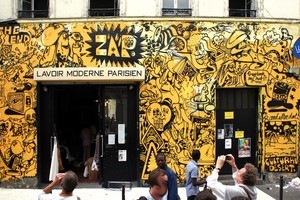 LMP is protesting against the eviction and building its case around its status as a verifiable cultural institution. Despite claiming that the incumbent decision-makers at the Mairie de Paris are against them for political reasons, LMP remains open for the moment and with a healthy program of events.
LMP is protesting against the eviction and building its case around its status as a verifiable cultural institution. Despite claiming that the incumbent decision-makers at the Mairie de Paris are against them for political reasons, LMP remains open for the moment and with a healthy program of events.
One of the sparkling delights of the underground side to Paris is Le M.U.R., in Paris’ 11th arrondissement, which has taken the raw energy of street art – that is, artwork put up in the urban space without permission – and channelled it onto a three by eight meter former billboard advertising space. The name, an acronym made from the French word for wall, and standing for Modulable, Urbain et Reactif, was formalized as an association in 2007.
The billboard’s provenance is that the former corporate owner became so tired of artists replacing its adverts with artworks that it eventually surrendered the space, leaving a note in the middle of the board: something along the lines of, “We’ve had enough! There you go!”. Then, unofficially curated for a while afterwards, two street artists, Thomas Schmittt and Jean Faucheur, got organised and created an association, also managing to secure funding from the Mairie de Paris.
Today Le M.U.R. is looked upon as a landmark venture, with each artist being given a stipend of €500, and the Mairie de Paris apparently making no comment on the money spent cleaning up the ‘artwork’ produced by the same artists in other parts of the city without permission.
The artwork is refreshed every two weeks, and to mark each new piece there is a vernissage, or opening, with some alcohol served and the chance to meet and talk with the exhibiting artist.
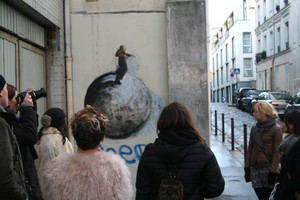 Le M.U.R. is one facet of the ecosystem surrounding street art, which has grown especially in the years since 2005, caused by the rise in internet usage. British stencil artist, Bansky, the lion in the jungle, and arguably the most well-known living artist in the world (Damien Hirst being the richest!), is a prime example of the way artists can now live off of what they do through selling artwork in galleries and directly through their websites, or from participating in the ever increasing number of urban art festivals springing up all over the world. We have also witnessed the rise in popularity of the street art tour. (Paris boasts an especially great one, offered by Underground Paris, a business established by the author of this article).
Le M.U.R. is one facet of the ecosystem surrounding street art, which has grown especially in the years since 2005, caused by the rise in internet usage. British stencil artist, Bansky, the lion in the jungle, and arguably the most well-known living artist in the world (Damien Hirst being the richest!), is a prime example of the way artists can now live off of what they do through selling artwork in galleries and directly through their websites, or from participating in the ever increasing number of urban art festivals springing up all over the world. We have also witnessed the rise in popularity of the street art tour. (Paris boasts an especially great one, offered by Underground Paris, a business established by the author of this article).
Taking groups into Paris’ more eclectic neighborhoods to look at what many would count as vandalism a priori has now become a niche business, with Berlin, London and Buenos Aires all boasting their own established street art tours, too.
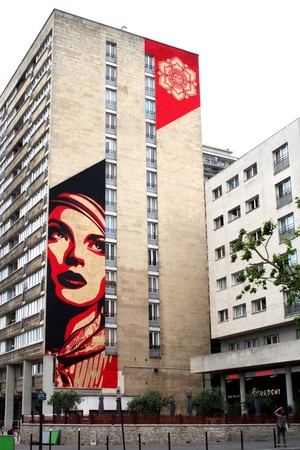 Paris is among one of a handful of street art capitals around the world, including New York, London, Berlin and Buenos Aires, and boasts a number of the movement’s most revered practitioners. The artist who calls himself Space Invader, lives and works in Paris, and is probably the world’s third most well-known street artist, after Banksy and Shepard Fairey (the artist behind the Barack Obama ‘Hope’ poster campaign). Space Invader creates mosaics inspired by the 1980s video game of the same name, and since the invasion began in 1998, he has installed over 1000 of his artworks around the city. He is well recognized and adored by Parisians, however, not all of them know that he is a street artist, and the story goes that, caught up a ladder having just installed a new piece, the police drove by and requested that he not remove the work, telling him it was “supposed to be there.”
Paris is among one of a handful of street art capitals around the world, including New York, London, Berlin and Buenos Aires, and boasts a number of the movement’s most revered practitioners. The artist who calls himself Space Invader, lives and works in Paris, and is probably the world’s third most well-known street artist, after Banksy and Shepard Fairey (the artist behind the Barack Obama ‘Hope’ poster campaign). Space Invader creates mosaics inspired by the 1980s video game of the same name, and since the invasion began in 1998, he has installed over 1000 of his artworks around the city. He is well recognized and adored by Parisians, however, not all of them know that he is a street artist, and the story goes that, caught up a ladder having just installed a new piece, the police drove by and requested that he not remove the work, telling him it was “supposed to be there.”
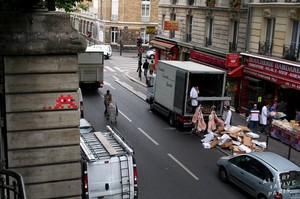 Space Invader, like Banksy, has managed to keep his personal identity concealed from the public, but it is understood that he works out of a studio in Montreuil, in the east of Paris, an area steadily becoming Paris’ next artists’ quarter.
Space Invader, like Banksy, has managed to keep his personal identity concealed from the public, but it is understood that he works out of a studio in Montreuil, in the east of Paris, an area steadily becoming Paris’ next artists’ quarter.
A former squat, now bordering on becoming a cultural institution, Jour et Nuit Culture, do not have a slick marketing strategy telling you what is happening without having to dig a little, nor do they offer any kind of online payment gateway for the events they organize. However they are a formalized association, while retaining all that is good and free of your average free space. Attend an event and be prepared for art exhibitions of work by its resident and local artists, a dynamic array of art workshops and dance classes, as well as activities in the field of Accrobranche and weekly bicycle repair workshops, which were previously offered by Paris’ bicycle rights campaign organization, Velorution, until the neighbors started to complain at the permanent throng of the group’s presence.
In addition to its photography studio and darkroom facilities, which can be rented out at reasonable rates, it is also currently in the process of building a music studio.
The president of the association of Jour et Nuit, Alexandre Grey, has floated to the top of this enterprise due to his experience in the museum sector, as well as his work in Accrobranche, the art of building structures in the tops of trees. Accrobranche led him to sail the Atlantic twice to and from French Guyana, and to travel to sub-Saharan Africa, again to practice and teach locals how to build in the tree tops. After a time working in a Paris museum and living in a ‘golden cage’ he decided he wanted to live a freer existence and so he grouped together with some like minded people and sought out the free space, a former electricity company HQs, left vacant after the company lost its contract with the Mairie of the 15th arrondissement. The association has since proved to the local government that it is using the premises in a worthwhile manner and has actually signed a contract whereby the association agrees that in exchange for paying a peppercorn rent, it must fulfill an obligation to the public by providing open cultural events and workshops. The government intends to eventually turn the space into apartments and the association will be evicted, but until that happens the bureaucrats seem to be happy having a dynamic arts centre for its residents at next to no cost.
Ruby Comet is a contributor at street art and fringe culture blog, Underground Paris, which offers street art tours and graffiti art workshops.
More in Le M.U.R., LMP, street art, streets of paris

